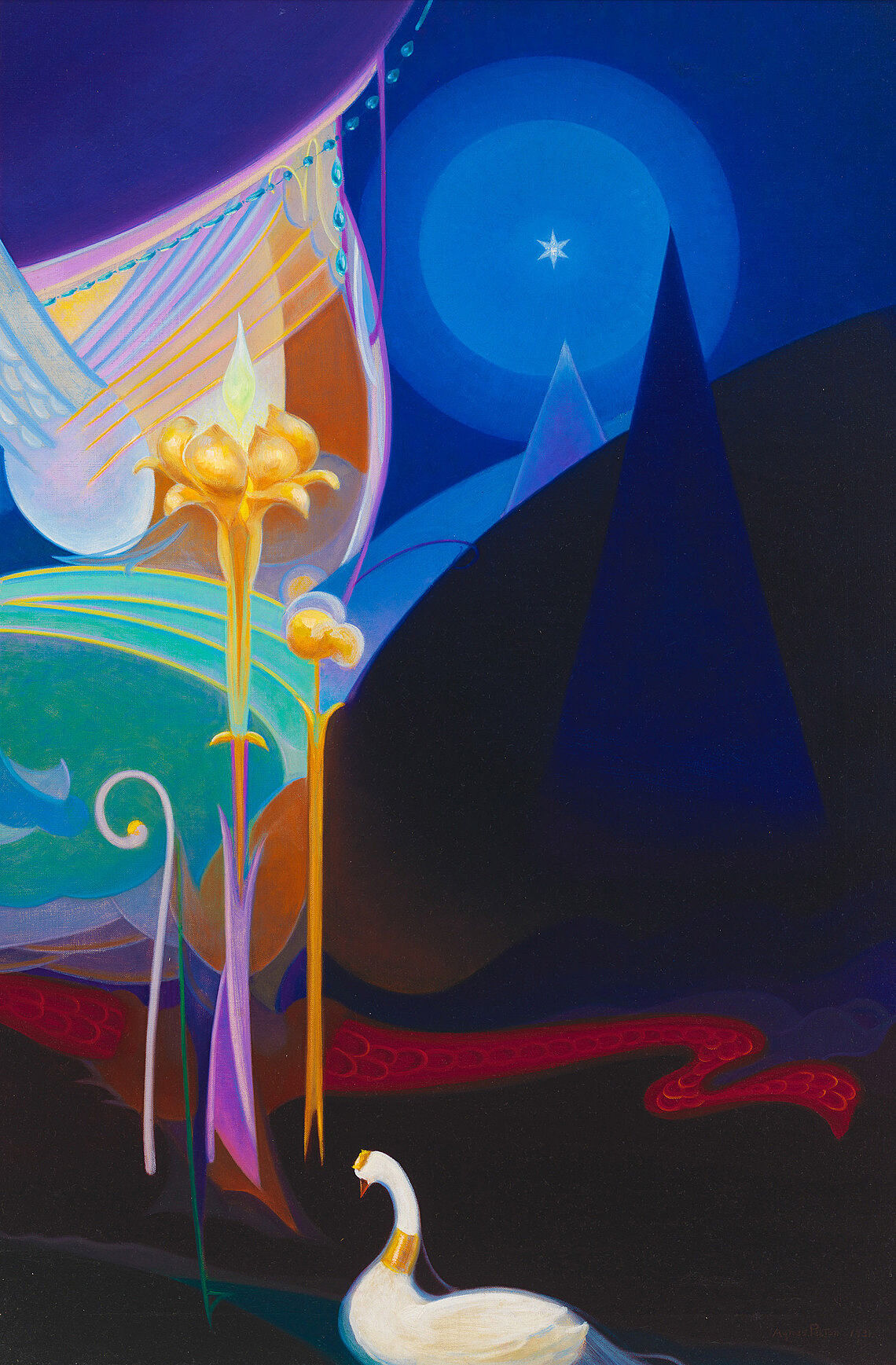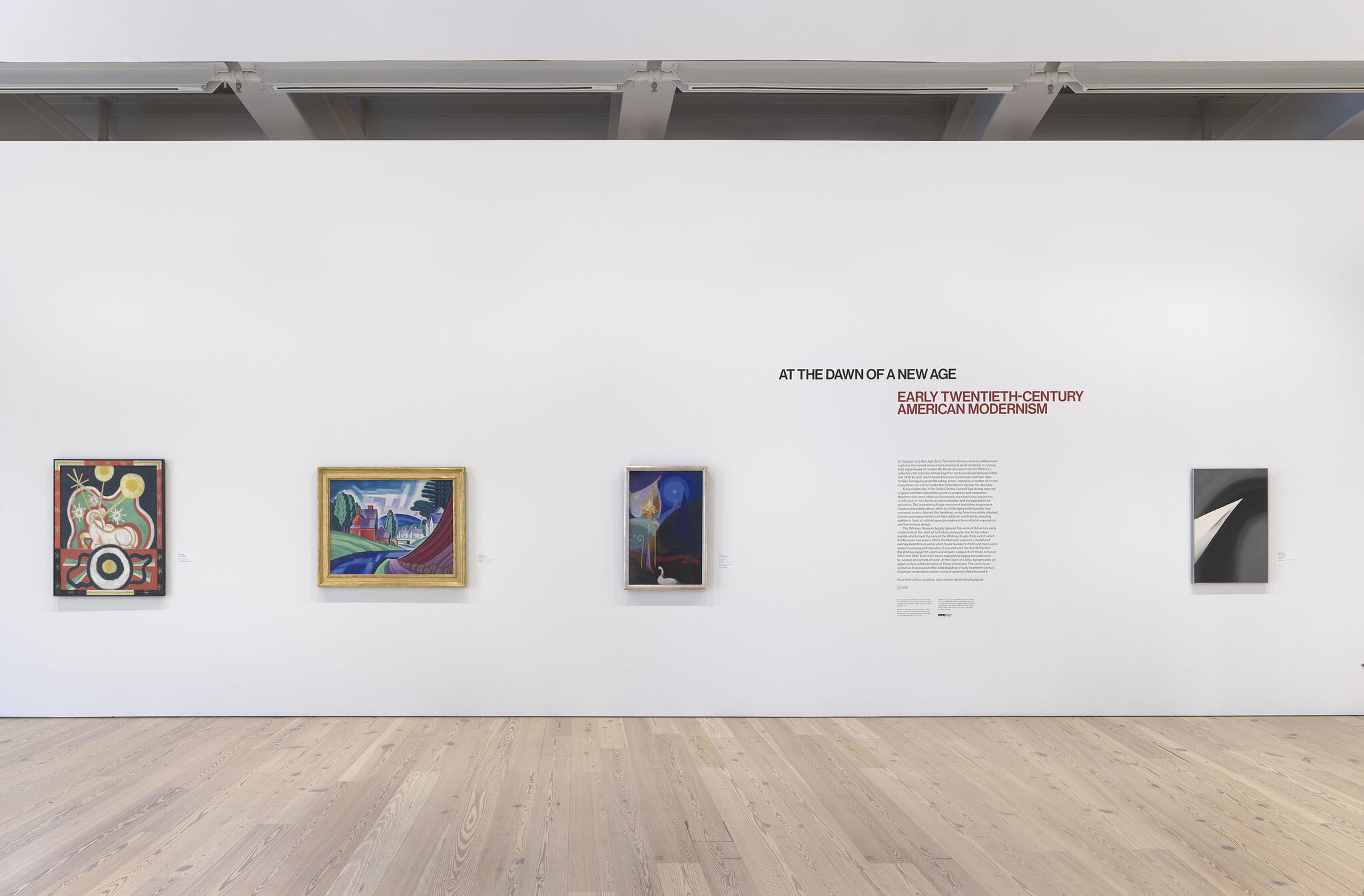Visual description
Agnes Pelton’s Ahmi in Egypt (1931) is an oil painting on canvas. It measures 36 and 3/16th inches in height and 24 3/16th inches in width. It measures 91.9 centimeters in height and 61.4 centimeters in width.
This painting is of an imaginary, mystical landscape. At the bottom center of this vertical painting is a small white swan—its head sits atop its arching neck and faces our left. The swan has a gold band around its neck and a gold mark on top of its head. Behind the swan to our left are three strange vertical plants. All three stand close together and are architectural in nature. The first one on the far left is pale violet and curls at the top with a yellow bud at its tip. The tallest plant is in the center and rises from a violet stalk to a head that resembles a royal golden scepter with a diamond shape bursting forth at its tip. Next is a golden stemmed plant with two round yellow fruits that hang from its head. Behind the plants but lower - is a red ripple that snakes across the dark surface of the water from the left to the right side of the painting. The water flows in front of a large dark mountain that curves up the right of the canvas. On the mountain is the triangle shape of a dark blue tree: its tip rises over the mountain into the evening sky.
To the lower left of the painting behind the three plants, there are odd decorative shapes that float into the sky. One is mint green with blue and yellow patterns. Behind that is a lilac shape—curved at its bottom and arched at its top—with patterns of blue, green, and orange. These shapes tumble up into a midnight blue sky. If we move our eyes to the top right of the painting, we can make out the light blue tip of another tree somewhere in the distance behind the dark mountain. But the real drama in this area is a small twinkling star that hovers in the center of two concentric circles of differing shades of blue—the center circle is larger and lighter blue in color. This glowing orb floats in a dark blue night sky.
Not on view
Date
1931
Classification
Paintings
Medium
Oil on canvas
Dimensions
Overall: 36 3/16 × 24 3/16 in. (91.9 × 61.4 cm)
Accession number
96.175
Series
Star Icons
Credit line
Purchase, with funds from the Modern Painting and Sculpture Committee
Rights and reproductions
© artist or artist's estate
Audio
-
Verbal Description: Agnes Pelton, Ahmi in Egypt
In At the Dawn of a New Age: Early Twentieth-Century American Modernism
0:00
Verbal Description: Agnes Pelton, Ahmi in Egypt
0:00
Agnes Pelton’s Ahmi in Egypt (1931) is an oil painting on canvas. It measures 36 and 3/16th inches in height and 24 3/16th inches in width. It measures 91.9 centimeters in height and 61.4 centimeters in width.
This painting is of an imaginary, mystical landscape. At the bottom center of this vertical painting is a small white swan—its head sits atop its arching neck and faces our left. The swan has a gold band around its neck and a gold mark on top of its head. Behind the swan to our left are three strange vertical plants. All three stand close together and are architectural in nature. The first one on the far left is pale violet and curls at the top with a yellow bud at its tip. The tallest plant is in the center and rises from a violet stalk to a head that resembles a royal golden scepter with a diamond shape bursting forth at its tip. Next is a golden stemmed plant with two round yellow fruits that hang from its head. Behind the plants but lower - is a red ripple that snakes across the dark surface of the water from the left to the right side of the painting. The water flows in front of a large dark mountain that curves up the right of the canvas. On the mountain is the triangle shape of a dark blue tree: its tip rises over the mountain into the evening sky.
To the lower left of the painting behind the three plants, there are odd decorative shapes that float into the sky. One is mint green with blue and yellow patterns. Behind that is a lilac shape—curved at its bottom and arched at its top—with patterns of blue, green, and orange. These shapes tumble up into a midnight blue sky. If we move our eyes to the top right of the painting, we can make out the light blue tip of another tree somewhere in the distance behind the dark mountain. But the real drama in this area is a small twinkling star that hovers in the center of two concentric circles of differing shades of blue—the center circle is larger and lighter blue in color. This glowing orb floats in a dark blue night sky.
-
Agnes Pelton, Ahmi in Egypt
In At the Dawn of a New Age: Early Twentieth-Century American Modernism (Spanish)
0:00
Agnes Pelton, Ahmi in Egypt
0:00
Carrie Moyer: La obra Ahmi in Egypt, realizada por Agnes Pelton en 1931, da la sensación de ser una especie de fotograma cinematográfico. Tiene una luz resplandeciente y sombras muy intensas.
Narrator: Nos habla la artista Carrie Moyer.
Carrie Moyer: Estamos ante algo que es una silueta. Suponemos que es una especie de ladera o un contrafuerte, y tiene esta fantástica extensión o un tipo de flor que brilla en el lado izquierdo, y el cisne en primer plano. Es una obra grandiosa de un modo interesante.
Esta pintura se realizó unos años después de que se encontrara la tumba de Tutankamón, por lo que esta idea sobre el antiguo Egipto, así como la fascinación que los diseñadores y artistas tenían por él, nutre las ideas en torno al art decó y el tipo de estética del art decó. Esto se puede ver en la pintura porque todo es muy redondo y estilizado, hay algo evidentemente mágico aquí. Parece ser un poco más descriptiva que algunas de sus otras pinturas, que tienden a ser más abstractas. Se siente como si fuera parte de un cuento de hadas, o quizás una especie de campamento, donde los protagonistas están del lado izquierdo; pero tiene colores muy saturados y vibrantes, y por eso es una obra realmente inusual para esta época.
-
0:00
Agnes Pelton, Ahmi in Egypt
0:00
Carrie Moyer: Agnes Pelton's Ahmi in Egypt from 1931 gives the sense of a kind of film still. It has this kind of glowing light and really hard shadows.
Narrator: Artist Carrie Moyer.
Carrie Moyer: So we're looking at something that is silhouetted. We assume it's a kind of hillside or some abutment with this fantastic—I almost want to say extension or some kind of flower—that's glowing to the left, with the swan in the foreground. It's so grandiose in this interesting way.
This painting was made a few years after Tutankhamun's tomb was found this idea about ancient Egypt, and the fascination that designers and artists had with ancient Egypt, feeds into the ideas around art deco and the aesthetics of art deco. You can see this in the painting because everything in it incredibly rounded and stylized, there's something obviously magical about this. It feels a little bit more descriptive than some of her other paintings, which tend to be more abstract. So this feels like it's part of a fairytale, or some kind of encampment or something where the protagonists are off to the left, but the colors in it are completely saturated and vibrant, and for that reason really unusual for this time.
Exhibitions
-

At the Dawn of a New Age: Early Twentieth-Century American Modernism
May 7, 2022–Feb 26, 2023
-

Agnes Pelton: Desert Transcendentalist
Mar 13–Nov 1, 2020
-

Where We Are: Selections from the Whitney’s Collection, 1900–1960
Apr 28, 2017–June 2, 2019
-

The Whitney's Collection
Sept 28, 2015–Apr 4, 2016
-

America Is Hard to See
May 1–Sept 27, 2015
-

Modern Life: Edward Hopper and His Time
Oct 28, 2010–Apr 10, 2011
-

Highlights from the Permanent Collection: From Hopper to Mid-Century
Feb 26, 2000–May 21, 2006
Installation photography
-


Installation view of At the Dawn of a New Age: Early Twentieth-Century American Modernism (Whitney Museum of American Art, New York, May 4, 2022-January 2023). From left to right: Marsden Hartley, Forms Abstracted, 1914; Oscar Bluemner, Space Motive, a New Jersey Valley, 1913-14; Agnes Pelton, Ahmi in Egypt, 1931; Georgia O’Keeffe, Black and White, 1930. Photograph by Ron Amstutz
From the exhibition At the Dawn of a New Age: Early Twentieth-Century American Modernism
-


Installation view of Agnes Pelton: Desert Transcendentalist (Whitney Museum of American Art, New York, March 13–November 1, 2020). From left to right: Return, 1940; Ahmi in Egypt, 1931; Being, 1926; Ecstasy, 1928; Meadowlark’s Song, Winter, 1926; The Ray Serene, 1925. Photograph by Ron Amstutz
From the exhibition Agnes Pelton: Desert Transcendentalist
-


Installation view of Agnes Pelton: Desert Transcendentalist (Whitney Museum of American Art, New York, March 13–November 1, 2020). From left to right: Voyaging, 1931; Sea Change, 1931; Sand Storm, 1932; Return, 1940; Ahmi in Egypt, 1931. Photograph by Ron Amstutz
From the exhibition Agnes Pelton: Desert Transcendentalist
-


Installation view of Agnes Pelton: Desert Transcendentalist (Whitney Museum of American Art, New York, March 13–November 1, 2020). From left to right: Return, 1940; Ahmi in Egypt, 1931. Photograph by Ron Amstutz
From the exhibition Agnes Pelton: Desert Transcendentalist
-


Installation view of Agnes Pelton: Desert Transcendentalist (Whitney Museum of American Art, New York, March 13–November 1, 2020). From left to right: The Guide, 1929; Day, 1935; Messengers, 1932; Voyaging, 1931; Return, 1940; Ahmi in Egypt, 1931. Photograph by Ron Amstutz
From the exhibition Agnes Pelton: Desert Transcendentalist
-


Installation view of Agnes Pelton: Desert Transcendentalist (Whitney Museum of American Art, New York, March 13–November 1, 2020). From left to right: Room Decoration in Purple and Gray, 1917; Voyaging, 1931; Return, 1940; Ahmi in Egypt, 1931. Photograph by Ron Amstutz
From the exhibition Agnes Pelton: Desert Transcendentalist

